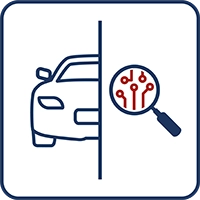
Why is miniaturization essential to advanced safety?
contact us

As we progress towards Level 3 autonomy and beyond, modern vehicle designs are becoming focused on a growing number of complex electronic components.
Today, automotive electronics play an important role in most areas of vehicle performance, including engine management, in-car entertainment systems, telematics and critical safety systems such as Advanced Driver Assistance Systems (ADAS). Meanwhile, in an attempt to reduce weight and emissions, designers are targeting smaller and lighter designs – but this means space for electronics is at a premium. As we move control over to automotive electronics, we’re fast running out of space in which to add new devices, cable harnesses and assemblies.
One option is to design smaller electronics – or undergo the path of miniaturization. This is a common technique within the consumer electronics industry whereby circuit board designs are becoming increasingly smaller without jeopardizing processing power, efficiency or reliability.
Miniaturizing automotive electronics offers several design advantages. Not only does it facilitate greater design freedom, since more electronic hardware can be installed in the same space, but it also helps to shorten the distance any electrical current would need to travel, enabling rapid pro-cessing so that vehicles can take immediate action in the event of an issue, for example stopping the vehicle or slowing down. This is particularly pertinent in the age of vehicle autonomy, where the ca-pability to recognize environmental conditions and relay the information back to the user is essential for occupant safety.
Achieving reliability in miniaturization
Achieving reliability in miniaturization is another challenge that designers and material specifiers face. As electronics become smaller, their tolerances become more critical and small factors such as the space between features has effect on the overall speed of electronic performance and occupant safety.

Smaller designs must be able to withstand high degrees of pressure, be resistant to excess heat and vibration, and offer a long lifespan for the vehicle. As vehicles become more dependent on electronics, the performance demands placed on materials increase considerably, with very high heat-generating packages creating challenging operating conditions for hardware. Therefore, the overall vehicle architecture needs to be a significant consideration for OEMs and Tier 1s, as it is a continually evolving system that must be adjusted to suit different electronic configurations.
From hundreds to a few
Traditionally, more than 100 processors would be located throughout a vehicle for each in-car application. To reduce weight and maximize efficiency, manufacturers are integrating multiple features into four to six high processing powered electronic control units (ECUs), each with the capability to serve numerous functions. To ensure an acceptable cable length, ECUs need to be mounted in central positions within the vehicle, to ensure the appropriate interconnections can be made. Information from multiple safety sensors is being pulled into centralized units called domain controllers (DCU).
MacDermid Alpha Electronics Solutions is working with OEMs and Tier 1s to miniaturize critical safety electronics, while supporting greater processing power for lighter, smaller vehicle designs. We do this by utilizing our experience with the most intricate interconnected designs, to further solutions for current and future automotive requirements. Our team of experts understands the impact designs have on overall performance and reliability. By viewing the entire vehicle design at a systems level, it is possible to understand the relationship between the electronics of a vehicle and its wider architecture, ensuring all the electrical components in a car work together in harmony.
We are also market leaders in microvia filling and additive PCB processing for more precise circuit definition. Finally, we specialize in metal plating options for advanced semiconductor packaging from wafer fabrication to backend attachment. All of these techniques help to miniaturize critical electronic components, create additional design space and increase robustness and reliability to ensure safer vehicle designs.
Why not contact us today to discover how we can help your company reach its miniaturization goals? Please contact info@esiauto.com